外研版高中英语必修3全套教案
新外研社高中英语必修三Unit3 The world of Science整单元完整教学设计

新外研社版高中英语必修三Unit 3 The World of ScienceStarting out&Understanding ideas教学设计教学目标:By the end of this period, students will be able to:1.Watch a video and extract the key information from it;2.Know and master the main features of an interview;3.Understand this passage to obtain relevant details;4.Improve critical thinking skills and try to give some useful suggestions.教学重难点:1.Summarise the inventions and usage of acquiring language knowledge;2.Understand the future trends in global technology development, form an international perspective, and deepen your understanding of the unit theme.教学方式:P-W-P教学法,Task-based Teaching Method.教学设计:Step ⅠLead-inActivity1Watch a videoWatch the video and answer the questions.1.Which of the inventions in the video interests you most?Why?2.Which of the inventions in the video do you think will become a reality?3.Of all the inventions in the world,which do you think is the most useful? Why?Suggested answers:Students’ own answers.Activity2Look at the picturesLook at the pictures and talk about how the way we live has changed over time.Discuss the reasons behind these changes.Suggested answers:Students’ own answers.Step ⅠWhile-readingActivity1Read for the main ideaChoose the sentences that describe Dr Fairhurst’s opinions.Suggested answers:2,4Activity2Language points and translation1.In addition,important advances have been made in medicine and environmental science thanks to increasing computer power.【翻译】此外,得益于不断强化的计算机能力,医药与环境科学也取得了重要进展。
教案必修三英语外研社

教案必修三英语外研社教案标题:必修三英语外研社教案目标:1.通过本节课的学习,学生将能够掌握必修三英语外研社教材中的重要知识点和技能。
2.培养学生的英语听、说、读、写能力,提高他们的英语综合运用能力。
3.激发学生对英语学习的兴趣和自信心,培养他们的学习动力和学习策略。
教学重点:1.掌握必修三英语外研社教材中的重要词汇和短语。
2.理解和运用教材中的语法知识,如时态、语态、虚拟语气等。
3.培养学生的阅读理解能力和写作能力。
教学难点:1.帮助学生理解和运用文中的生词和短语。
2.引导学生正确理解和运用语法知识。
3.提高学生的阅读和写作水平。
教学准备:1.教材:必修三英语外研社教材。
2.多媒体设备:投影仪、电脑等。
3.教学资源:课件、练习题、教学视频等。
教学过程:一、导入(5分钟)1.利用图片或视频引入本课的主题,激发学生对英语学习的兴趣。
2.通过提问或小组讨论,了解学生对本单元主题的初步了解和认识。
二、新课讲解(15分钟)1.通过投影仪或电脑展示教材中的重要词汇和短语,帮助学生掌握并记忆。
2.解释和讲解教材中的语法知识,如时态、语态、虚拟语气等,帮助学生理解和运用。
三、阅读理解(20分钟)1.分发教材中的阅读材料,让学生独立阅读并回答相关问题。
2.组织学生进行小组讨论,分享自己的理解和答案。
3.带领全班共同讨论,梳理重要信息和答案,解决学生的疑问。
四、写作练习(20分钟)1.给学生提供写作任务,如写一篇关于本单元主题的短文或写一封英文邮件。
2.引导学生使用教材中的词汇、短语和语法知识,组织他们进行写作练习。
3.鼓励学生相互交流和修改,提供反馈和建议,帮助他们提高写作水平。
五、课堂总结(5分钟)1.总结本节课的重点和难点,强调学生需要继续复习和巩固的内容。
2.鼓励学生提出问题和反馈意见,以便教师进行进一步的指导和辅导。
六、作业布置(5分钟)1.布置相关的课后作业,如完成练习题、背诵单词和短语等。
2.提供相关的学习资源和参考资料,引导学生进行自主学习和拓展。
外研版高中英语必修3全套教案
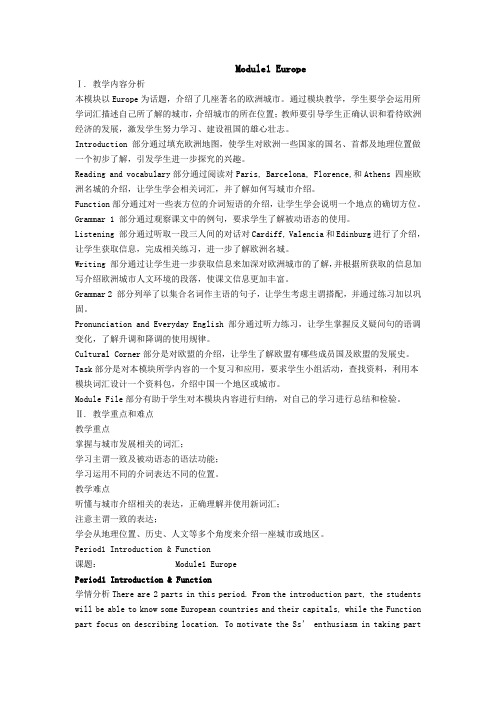
Module1 EuropeⅠ. 教学内容分析本模块以Europe为话题,介绍了几座著名的欧洲城市。
通过模块教学,学生要学会运用所学词汇描述自己所了解的城市,介绍城市的所在位置;教师要引导学生正确认识和看待欧洲经济的发展,激发学生努力学习、建设祖国的雄心壮志。
Introduction 部分通过填充欧洲地图,使学生对欧洲一些国家的国名、首都及地理位置做一个初步了解,引发学生进一步探究的兴趣。
Reading and vocabulary部分通过阅读对Paris, Barcelona, Florence,和Athens 四座欧洲名城的介绍,让学生学会相关词汇,并了解如何写城市介绍。
Function部分通过对一些表方位的介词短语的介绍,让学生学会说明一个地点的确切方位。
Grammar 1 部分通过观察课文中的例句,要求学生了解被动语态的使用。
Listening 部分通过听取一段三人间的对话对Cardiff, Valencia和Edinburg进行了介绍,让学生获取信息,完成相关练习,进一步了解欧洲名城。
Writing 部分通过让学生进一步获取信息来加深对欧洲城市的了解,并根据所获取的信息加写介绍欧洲城市人文环境的段落,使课文信息更加丰富。
Grammar 2 部分列举了以集合名词作主语的句子,让学生考虑主谓搭配,并通过练习加以巩固。
Pronunciation and Everyday English 部分通过听力练习,让学生掌握反义疑问句的语调变化,了解升调和降调的使用规律。
Cultural Corner部分是对欧盟的介绍,让学生了解欧盟有哪些成员国及欧盟的发展史。
Task部分是对本模块所学内容的一个复习和应用,要求学生小组活动,查找资料,利用本模块词汇设计一个资料包,介绍中国一个地区或城市。
Module File部分有助于学生对本模块内容进行归纳,对自己的学习进行总结和检验。
Ⅱ. 教学重点和难点教学重点掌握与城市发展相关的词汇;学习主谓一致及被动语态的语法功能;学习运用不同的介词表达不同的位置。
外研版英语必修三教案
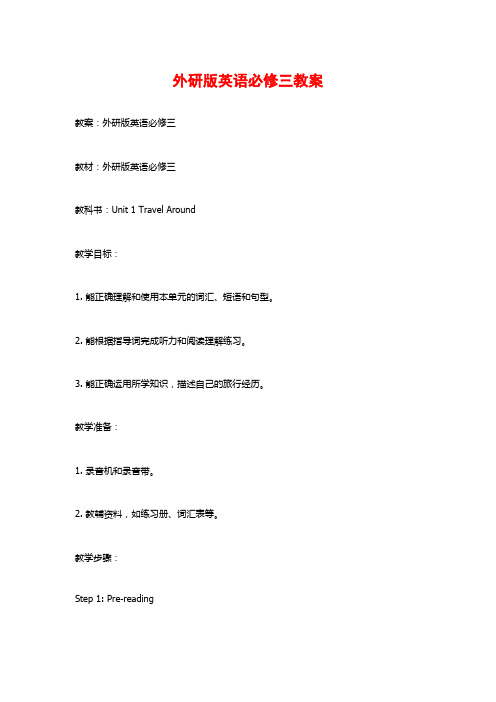
外研版英语必修三教案教案:外研版英语必修三教材:外研版英语必修三教科书:Unit 1 Travel Around教学目标:1. 能正确理解和使用本单元的词汇、短语和句型。
2. 能根据指导词完成听力和阅读理解练习。
3. 能正确运用所学知识,描述自己的旅行经历。
教学准备:1. 录音机和录音带。
2. 教辅资料,如练习册、词汇表等。
教学步骤:Step 1: Pre-reading1. Lead-in: Show students some pictures of different famous tourist attractions around the world. Ask them if they have ever been to any of these places or if they would like to visit them.2. Pre-reading questions: Distribute the pre-reading questions to the students and ask them to answer the questions individually. Then, have a class discussion to check their answers.Step 2: While-reading1. Listening: Play the audio recording of the text to the students. Ask them to listen carefully and take notes if necessary. After the recording, discuss the answers as a class.2. Reading: Ask the students to read the text silently first, and then read it aloud in pairs. In pairs, they can discuss any new vocabulary or unfamiliar phrases that they come across.Step 3: Post-reading1. Vocabulary exercises: Distribute the vocabulary exercises to the students. They should complete the exercises individually and then check their answers in pairs.2. Comprehension questions: Distribute the comprehension questions to the students. They should answer the questions individually and then discuss their answers in pairs.3. Speaking activity: Divide the students into pairs or small groups. Instruct them to discuss their own travel experiences, using the vocabulary and phrases from the text. Encourage them to ask each other questions and share interesting stories.Step 4: Review and wrap-up1. Review: Recycle the vocabulary and phrases from the unit by playing a vocabulary game or doing a quick review exercise.2. Homework: Assign relevant exercises from the workbook or other homework tasks to reinforce the learning from this unit.教学扩展:1. 通过游戏或小组讨论,鼓励学生分享自己的旅行经历。
英语外研版必修3全套教案文库
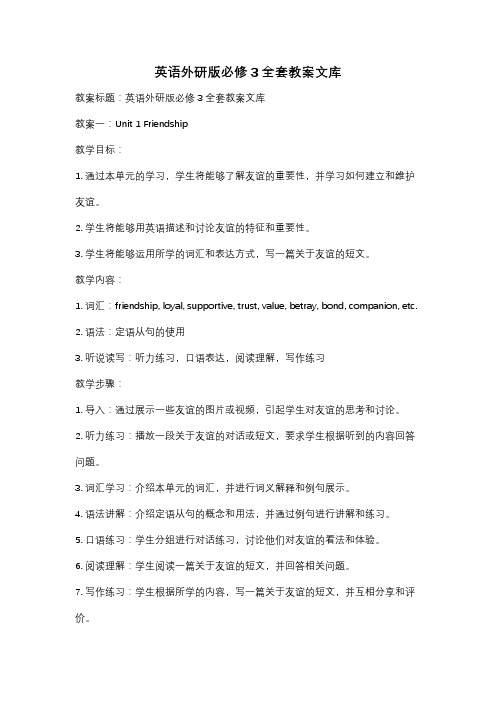
英语外研版必修3全套教案文库教案标题:英语外研版必修3全套教案文库教案一:Unit 1 Friendship教学目标:1. 通过本单元的学习,学生将能够了解友谊的重要性,并学习如何建立和维护友谊。
2. 学生将能够用英语描述和讨论友谊的特征和重要性。
3. 学生将能够运用所学的词汇和表达方式,写一篇关于友谊的短文。
教学内容:1. 词汇:friendship, loyal, supportive, trust, value, betray, bond, companion, etc.2. 语法:定语从句的使用3. 听说读写:听力练习,口语表达,阅读理解,写作练习教学步骤:1. 导入:通过展示一些友谊的图片或视频,引起学生对友谊的思考和讨论。
2. 听力练习:播放一段关于友谊的对话或短文,要求学生根据听到的内容回答问题。
3. 词汇学习:介绍本单元的词汇,并进行词义解释和例句展示。
4. 语法讲解:介绍定语从句的概念和用法,并通过例句进行讲解和练习。
5. 口语练习:学生分组进行对话练习,讨论他们对友谊的看法和体验。
6. 阅读理解:学生阅读一篇关于友谊的短文,并回答相关问题。
7. 写作练习:学生根据所学的内容,写一篇关于友谊的短文,并互相分享和评价。
教学评估:1. 口语表达评估:观察学生在口语练习中的表达能力和语法运用情况。
2. 阅读理解评估:检查学生对于友谊相关文章的理解能力和问题回答的准确性。
3. 写作评估:评估学生写作能力和对友谊的理解和表达。
教案二:Unit 2 Healthy eating教学目标:1. 通过本单元的学习,学生将能够了解健康饮食的重要性,并学习如何选择和准备健康食物。
2. 学生将能够用英语描述和讨论健康饮食的原则和方法。
3. 学生将能够运用所学的词汇和表达方式,写一篇关于健康饮食的短文。
教学内容:1. 词汇:healthy eating, balanced diet, nutrients, vitamins, minerals, carbohydrates, protein, etc.2. 语法:情态动词的使用3. 听说读写:听力练习,口语表达,阅读理解,写作练习教学步骤:1. 导入:通过展示一些健康食物的图片或视频,引起学生对健康饮食的思考和讨论。
202X年外研版英语必修三教案
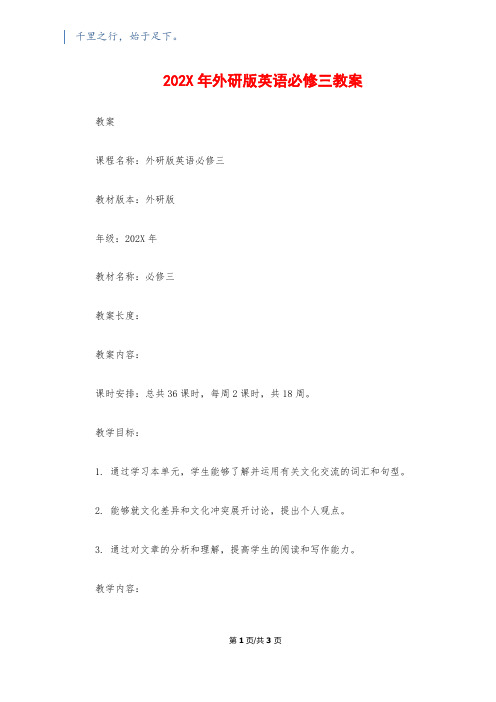
千里之行,始于足下。
202X年外研版英语必修三教案教案课程名称:外研版英语必修三教材版本:外研版年级:202X年教材名称:必修三教案长度:教案内容:课时安排:总共36课时,每周2课时,共18周。
教学目标:1. 通过学习本单元,学生能够了解并运用有关文化交流的词汇和句型。
2. 能够就文化差异和文化冲突展开讨论,提出个人观点。
3. 通过对文章的分析和理解,提高学生的阅读和写作能力。
教学内容:第1页/共3页锲而不舍,金石可镂。
第一课时:Unit 1 Cultural relics教学目标:1. 学生能够了解并掌握与文化遗产相关的词汇。
2. 学生能够就文化遗产的保护问题展开讨论。
教学步骤:1. Warm-up教师通过展示一些知名的文化遗产图片,引导学生讨论并了解文化遗产的概念。
2. Presentation教师出示文化遗产相关的词汇卡片,学生分组进行学习和记忆。
3. Practice学生通过配对、填空等活动巩固所学的词汇。
4. Discussion教师引导学生讨论文化遗产的保护问题,并要求学生提出自己的观点。
5. Homework要求学生写一篇关于保护文化遗产的短文。
千里之行,始于足下。
教学评价:通过本节课的教学,学生能够了解文化遗产的概念和保护问题,并能够运用相关的词汇和句型进行交流和讨论。
学生通过讨论和写作任务,培养了自己的思辩能力和语言表达能力。
总结:通过本单元的学习,学生能够了解并运用有关文化交流的词汇和句型,并能够就文化差异和冲突展开讨论。
同时,通过对文章的分析和写作任务的完成,进一步提高了学生的阅读和写作能力。
通过本课,学生对文化遗产保护问题有了更深入的了解,并能够提出自己的观点。
第3页/共3页。
外研版高中英语必修三模块3高中英语教学设计
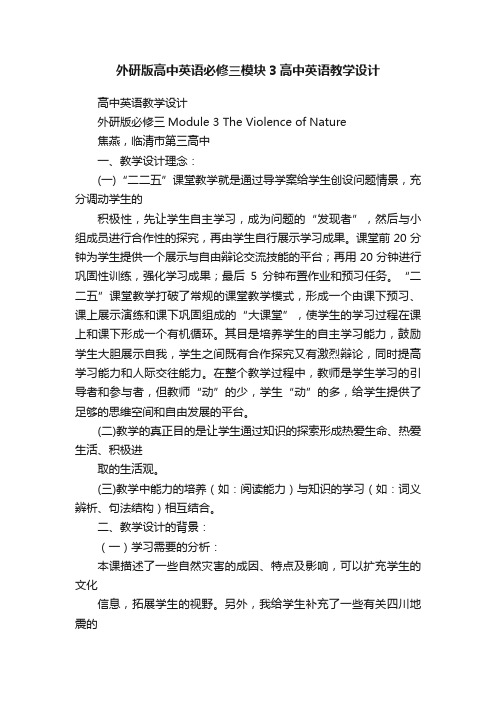
外研版高中英语必修三模块3高中英语教学设计高中英语教学设计外研版必修三Module 3 The Violence of Nature焦燕,临清市第三高中一、教学设计理念:(一)“二二五”课堂教学就是通过导学案给学生创设问题情景,充分调动学生的积极性,先让学生自主学习,成为问题的“发现者”,然后与小组成员进行合作性的探究,再由学生自行展示学习成果。
课堂前20分钟为学生提供一个展示与自由辩论交流技能的平台;再用20分钟进行巩固性训练,强化学习成果;最后5分钟布置作业和预习任务。
“二二五”课堂教学打破了常规的课堂教学模式,形成一个由课下预习、课上展示演练和课下巩固组成的“大课堂”,使学生的学习过程在课上和课下形成一个有机循环。
其目是培养学生的自主学习能力,鼓励学生大胆展示自我,学生之间既有合作探究又有激烈辩论,同时提高学习能力和人际交往能力。
在整个教学过程中,教师是学生学习的引导者和参与者,但教师“动”的少,学生“动”的多,给学生提供了足够的思维空间和自由发展的平台。
(二)教学的真正目的是让学生通过知识的探索形成热爱生命、热爱生活、积极进取的生活观。
(三)教学中能力的培养(如:阅读能力)与知识的学习(如:词义辨析、句法结构)相互结合。
二、教学设计的背景:(一)学习需要的分析:本课描述了一些自然灾害的成因、特点及影响,可以扩充学生的文化信息,拓展学生的视野。
另外,我给学生补充了一些有关四川地震的图片和英文报道,激发学生用英语获取知识和解决问题的兴趣。
(二)学习内容的分析:外研版英语教材中的每一个单元都是围绕一个独立的话题展开,包括听、说、读、写等综合技能的训练。
本单元为高一必修三第三模块,教学内容为描述自然灾害。
目的是让学生通过完成本模块的任务,能够对所学语言灵活运用,熟练掌握有关自然灾害这一话题词汇和表达句型。
并通过模块学习使学生了解地震、飓风、龙卷风等各种自然灾害的成因、过程及所造成的严重后果。
培养学生对自然科学知识的渴求,对美好生活的热爱,激发他们学好自然科学服务于生活的热情。
高中英语外研版高中必修3Module1Europe-B3M1教案

Teaching objectives:At the end of the class,we will be able to:1. master some useful words and expressions from the text .2. know about four European cities.3. learn how to introduce a city.Textbook analysis:This period talks about four European cities,which helps students learn European cities and European culture,and then make them get the specific information.As a result,they can know how to introduce a city.Student analysisStudents are Senior One students,who master many words and have the ability to introduce a city.On the other hand,they are a little shy to show themselves.Teaching key points:How to master reading skills and get the information about European cities.Teaching difficult points:Talk about how to introduce a city.For example,how to introduce their hometown to others.Learn how to write a passage to introduce Longchang.Teaching methods:Task-based teaching methodLearning methods:Cooperative learning Task-based learningTeaching aids:Multi-media,blackboard.Teaching procedures:Step one Lead inA wonderful travel in Europe...Purpose:To let students know something about Europe and arouse students’ interest a lot.Step two Pre-readingQuestion:Look at the title and subtitles,how many cities are mentioned ?Purpose:To know how to get the answer from the title and subtitles.Step three While-readingFast reading1.Read the passage quickly and match the photos with descriptions.(Tip: Focus on the first sentence and the last sentence in each paragraph.)1.a landmark in Paris2.a building in Athens3.an art gallery in Florence4.a church in BarcelonaPurpose:From the pictures,to let students know more details about European cities,and get the background information.2.Answer the questions.1. Which of the cities are capital cities?2. Which one is situated on the coast?3. Which is famous for its places to eat?4. Which ones are or were important cities for writers and artists?5. Which was the world’s greatest city a long time ago?Purpose:To learn reading skills better-focus on the first sentence and the last sentence in each paragraph.Careful readingFind out the specific information.(Tip: Pay attention to some key words and key sentences.)Purpose:To let students know to pay attention to some key words and key sentences.Step four Post-readingSummary.1.Fill in the blanks.Paris, Barcelona, Florence and Athens are four great 1.________ (Europe) cities.Paris, one of the most beautiful cities in the world, is the capital and 2.________ (large) city of France. It is famous3._______ the Eiffel Tower, its restaurants, cafes and theaters.The second largest city of Spain is Barcelona,One of the famous4._______(landmark) is the Church of the Sagrada Familia5._______(design) by Antonio Gaudi.Florence, 6._______ Italian city, became famous for the Renaissance 7._______ began in the 1300s and lasted for 300 years and is now visited by about a million tourists each other.Athens, the birthplace of western civilization, 8._______ (be) the capital of Greece. It used to be the world’s most 9.________ (power) city. The work of Greece’s best writers 10.________ (influence) other writers ever since.Purpose:To improve students’ reading skill about how to summarize the passage.2.Answer a question.Which of them would you most like to visit?And why?Purpose:To know the passage better and learn a lot about European cities.3.Discuss with partners.Imagine you were a guide and a visitor.Make a dialogue and introduce your hometown to partners.Here are some useful expressions as follows.introduce their hometown.And educate students love their country.Step five Tips on after class learnig.Introduce Longchang to your partners after class and then write a short passage about Longchang. Purpose:To master students’ writing skills and develop their interest in English.Purpose:To make students have a general idea of this class.Teaching evaluation and reflection:I should do everything I can to activate classroom atmosphere and arouse students’ interest in English.Also,since my teaching method is traditional,in the near future,I’d better change my teaching method into a new one,where not the teacher but students are the center.。
- 1、下载文档前请自行甄别文档内容的完整性,平台不提供额外的编辑、内容补充、找答案等附加服务。
- 2、"仅部分预览"的文档,不可在线预览部分如存在完整性等问题,可反馈申请退款(可完整预览的文档不适用该条件!)。
- 3、如文档侵犯您的权益,请联系客服反馈,我们会尽快为您处理(人工客服工作时间:9:00-18:30)。
Module1 EuropeⅠ. 教学内容分析本模块以Europe为话题,介绍了几座著名的欧洲城市。
通过模块教学,学生要学会运用所学词汇描述自己所了解的城市,介绍城市的所在位置;教师要引导学生正确认识和看待欧洲经济的发展,激发学生努力学习、建设祖国的雄心壮志。
Introduction 部分通过填充欧洲地图,使学生对欧洲一些国家的国名、首都及地理位置做一个初步了解,引发学生进一步探究的兴趣。
Reading and vocabulary部分通过阅读对Paris, Barcelona, Florence,和Athens 四座欧洲名城的介绍,让学生学会相关词汇,并了解如何写城市介绍。
Function部分通过对一些表方位的介词短语的介绍,让学生学会说明一个地点的确切方位。
Grammar 1 部分通过观察课文中的例句,要求学生了解被动语态的使用。
Listening 部分通过听取一段三人间的对话对Cardiff, Valencia和Edinburg进行了介绍,让学生获取信息,完成相关练习,进一步了解欧洲名城。
Writing 部分通过让学生进一步获取信息来加深对欧洲城市的了解,并根据所获取的信息加写介绍欧洲城市人文环境的段落,使课文信息更加丰富。
Grammar 2 部分列举了以集合名词作主语的句子,让学生考虑主谓搭配,并通过练习加以巩固。
Pronunciation and Everyday English 部分通过听力练习,让学生掌握反义疑问句的语调变化,了解升调和降调的使用规律。
Cultural Corner部分是对欧盟的介绍,让学生了解欧盟有哪些成员国及欧盟的发展史。
Task部分是对本模块所学内容的一个复习和应用,要求学生小组活动,查找资料,利用本模块词汇设计一个资料包,介绍中国一个地区或城市。
Module File部分有助于学生对本模块内容进行归纳,对自己的学习进行总结和检验。
Ⅱ. 教学重点和难点教学重点掌握与城市发展相关的词汇;学习主谓一致及被动语态的语法功能;学习运用不同的介词表达不同的位置。
教学难点听懂与城市介绍相关的表达,正确理解并使用新词汇;注意主谓一致的表达;学会从地理位置、历史、人文等多个角度来介绍一座城市或地区。
Period1 Introduction & Function课题: Module1 EuropePeriod1 Introduction & Function学情分析There are 2 parts in this period. From the introduction part, the students will be able to know some European countries and their capitals, while the Function part focus on describing location. To motivate the Ss’ enthusiasm in t aking partin the classroom activities, I can organize a group competition to decide which group will do the best in completing the tasks.课程目标知识与能力Help Ss get familiar with the name of some European countries and the main cities.Get Ss to describe the location of a country or a city in the similar way.过程与方法Train Ss speaking ability via the individual performances.Write similar sentences.Help Ss get prepared for reading.情感态度与价值观They can know more about European countries from the Introduction and also know how to describe their favourite places in an acceptable way via Function part.重点Improving the students’ oral ability. Description a place.难点How to help Ss improve their speaking ability.How to help Ss make to describe a place.Lead Ss to talk in class actively.教法Task-based Approach学法Cooperation 手段A tape recorder, A blackboard 教学过程Step 1. Lead-in: IntroductionIntroduce more about some European countries.Europe 欧洲Learn the new words and expressions.Step 2. Reading and MatchcountrycapitallanguageUnited kingdomLondonEnglishGreeceAthensGreekFranceParisFrenchItalyRomeItalianSpainMadridSpanishPortugalLisbonPortugueseGet the Ss to read the words in the table.Get the Ss to fill in the blanks.Get the Ss to do the Match with the map in pair.Step 3 FunctionRead the sentences and write similar sentences about TianjinItaly is in the south of Europe.Portugal is to the west of Spain.Barcelona is on the northeast coast of Spain.The UK is off the northwest of Europe.Now do you know how to describe location?Paris is situated ____the River Seine.There is a mountain _______France and Italy.Barcelona is a city ____the coast of Spain.Britain is an island ____the coast of Europe.France and England face each other ____ the English Channel.Mongolia is ________China and Russia.China is ________________of India.Guangzhou is ___________of China.Shenyang is _________Beijing and Harbin.Chongqing is situated ___the Yangtze River.The Qinghai-Tibet Plateau is______________of China.Step 4 SummaryIn this class the Ss mainly have learned some new words about European countriesand also know how to describe a place in an acceptable way.板书 Module1 Europe Periods 1locate/location/located be located on/in/toTian jin is situated on Haihe River,Tianjin is located in the north of China.Tianjin is on the north coast of China.Shanghai is on the east coast of China.Taiwan is off the east coast of China.反馈Workbook P68, Exs 6, 7 and P 69 Ex4 .作业Memorize the new words of this period. Preview the reading passage.反思 It is necessary and important to arouse the students’ interests and get all Ss involved in various interesting activities Period 2 Reading and Vocabulary课题: Module 1 EuropePeriod 2 Reading and Vocabulary学情分析This period is intended to improve the Ss’ reading ability via the reading passage. The Ss will be able to know more about the European countries like the location, history and custom. To arouse their interests, group works are very useful.课程目标知识与能力Make Ss learn to sum up grammatical rules themselves.Make sure Ss can apply the grammar correctly.Train Ss’ speaking ability.过程与方法Make Ss master some words, phrases and sentence patterns.Encourage Ss to participate in class actively.Help Ss to improve their reading ability.情感态度与价值观Train Ss speaking ability through individual and pair work. Explanations to help Ss to make sense of the passage better.Discussion to help Ss prepare for reading.重点Encourage the Ss to sum up grammatical rules.Help the Ss to improve their speaking ability.难点This section provides an opportunity for Ss to learn some vocabulary about countries. Meanwhile, they can know more about European countries.教法Task-based Approach学法Cooperation 手段A tape recorder, A blackboard 教学过程Step 1. Lead-in , Introduction and VocabularyIntroduce more about some European countries.Learn the new words and expressions.Step 2. ReadingRead the passage and match the photos with these descriptions.Ask the Ss to do the activity individually, then check with a partner.Call back the answers from the whole class, asking for whole sentences.1).Which of the cities are capital cities?2).Which one is situated on the coast?3).Which is famous for its places to eat?4).Which ones are or were important cities for writers and artists?5).Which was the world’s greatest city a long time ago?4.Read the passage again and decide if these sentences are true(T) or false(F)1).The Eiffel Tower is a tall building in France.( )2). There are a lot of restaurants and cafes in Paris.( )3).Barcelona is the capital of Spain. ( )4).The Church of the Sagrada Familia was built in 1926.( )5).The artistic movement called the Renaissance began in Florence.6). The Uffizi Palace is a famous hotel in Florence.( )7).A long time ago, Athens was the world’s most powerful city.( )8). There were a lot of good writers in ancient Athens.( )Step 3 Language Pointslo1. on the coast of, off the coast of,coast means the area where the land meets the oceanon the coast means on the land near the oceanoff the coast means in the ocean near the land2. face(动词)My house faces the sea.She turned to face me.He is facing the biggest challenge of his career.If found guilty, he could face up to 20 years in jail.I want to have a face- to -face talk with you.His father hit him in the face.3. acrossShe took a ship across the Atlantic.The boat carried them across the river.The police pushed their way through the crowd.across为穿过一个平面,而through为穿过一个立体空间4. be situated/located 加介词表示某物的位置。
